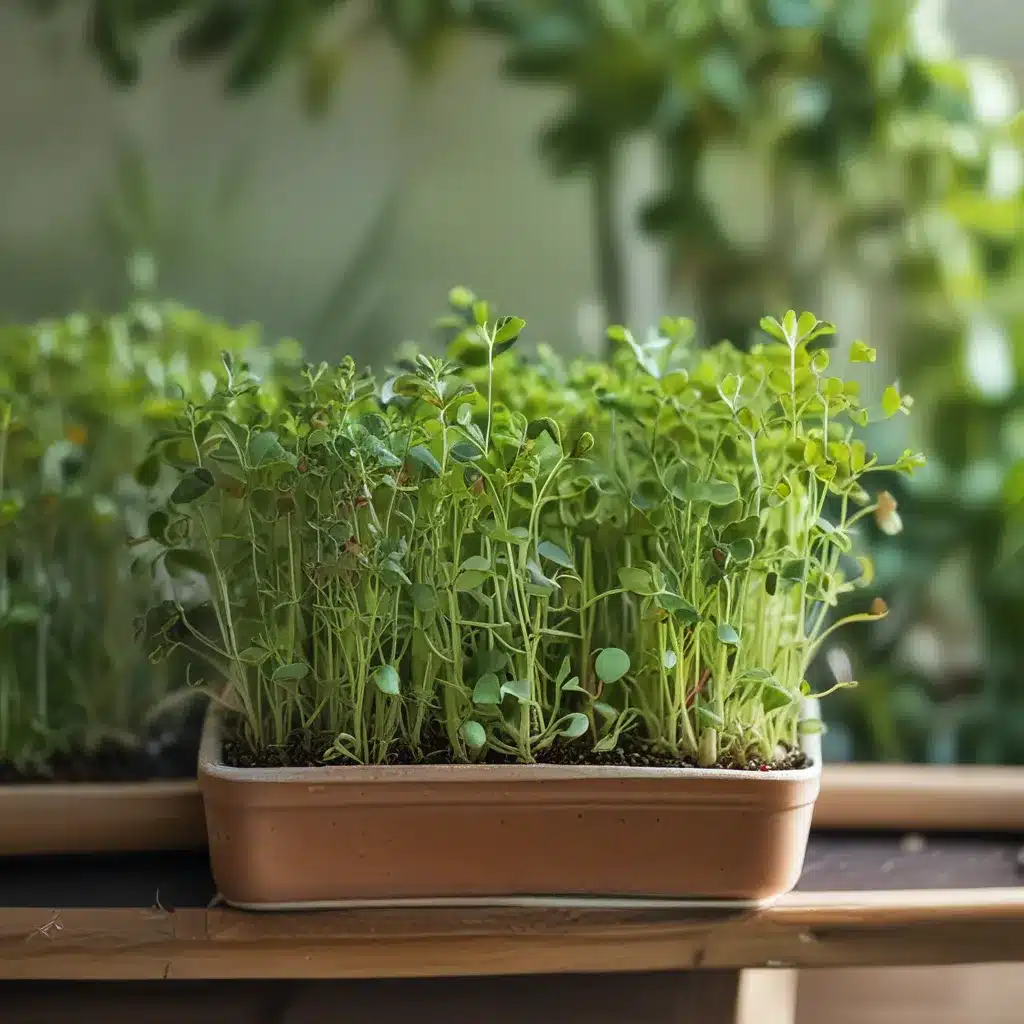
Ah, the wonders of microgreens! These tiny, mighty morsels have been taking the culinary world by storm, and for good reason. As a devoted home gardener and member of the Thornnapple Community Supported Agriculture (CSA) service, I’ve become absolutely enamored with the process of growing my own microgreens. Let me tell you, it’s a veritable microgreen mania at my place!
The Microgreen Mystique
Microgreens are the young, tender seedlings of various vegetables and herbs. While they may be miniature in size, they pack a serious nutritional punch. In fact, studies have shown that microgreens can contain up to 40 times more vitamins and antioxidants than their fully-grown counterparts! Seedmania notes that these little greens are a “powerhouse of concentrated nutrition” – they’re like veggie-superheroes in the making.
What I find most fascinating about microgreens is their versatility. You can grow practically any type of vegetable or herb as a microgreen, from classic kale and spinach to more exotic options like radish, beet, and even edible flowers. The possibilities are endless, and the flavors can range from sweet and mild to peppery and bold. It’s like having a whole garden’s worth of flavors at your fingertips, just waiting to be harvested and added to your culinary creations.
The Home Grower’s Guide to Microgreens
So, you’re intrigued and want to dive into the world of microgreens? Well, you’re in luck, because growing these mini-marvels at home is surprisingly easy and incredibly rewarding. Let me share my top tips for becoming a microgreen maestro.
Choosing the Right Seeds
The first step in your microgreen journey is selecting the right seeds. Fruition Seeds suggests opting for seeds that are specifically labeled as “microgreen” or “baby leaf” varieties. These are often smaller in size and grow more quickly than their full-size counterparts. Some popular microgreen options include broccoli, kale, arugula, mustard greens, and radish.
Setting up Your Growing Space
Now that you’ve got your seeds, it’s time to set up your growing area. Microgreens thrive in a controlled environment, so an indoor setup is ideal. University of Minnesota Extension explains that hydroponics, a soilless gardening method, is a great option for growing microgreens at home. You can use a simple deep water culture system with a container, net pots, and a growing medium like perlite or coco coir.
If you don’t want to go the hydroponic route, no problem! You can also grow microgreens in trays or containers filled with a high-quality potting mix. Just be sure to provide plenty of light, either from a sunny window or with the help of some grow lights.
Sowing and Caring for Your Microgreens
Once your growing setup is ready, it’s time to sow those precious seeds. Sprinkle them evenly over the growing medium, ensuring they have a bit of space to spread their (tiny) leaves. Gently mist the seeds with water, and then cover the tray with a lid or plastic wrap to maintain moisture.
As your microgreens start to sprout, be sure to remove the lid and provide them with plenty of light. Keep the growing medium moist but not waterlogged, and consider using a small fan to promote air circulation and prevent mold growth. With a little TLC, your microgreens will be ready to harvest in just 10-20 days, depending on the variety.
Harvesting and Enjoying Your Homegrown Gems
Ah, the moment you’ve been waiting for – harvest time! When your microgreens reach a height of 2-4 inches, it’s time to snip them off at the base using clean scissors or a sharp knife. Be sure to handle them gently to preserve their delicate texture.
The best part about homegrown microgreens? You can enjoy them in so many ways! Sprinkle them on salads, stir them into soups and stews, or use them as a garnish for your favorite dishes. Their vibrant colors and concentrated flavors will add a delightful touch to any meal. Plus, you can rest assured that your microgreens are 100% fresh and free of any nasty chemicals or pesticides.
The Microgreen Difference
As a member of the Thornnapple CSA, I’ve had the opportunity to try all sorts of incredible produce, but nothing quite compares to the experience of growing and enjoying my own microgreens. There’s just something so satisfying about nurturing these tiny powerhouses from seed to plate.
Not only do homegrown microgreens taste amazing, but they’ve also been shown to have significant health benefits. University of Minnesota Extension reports that these mini-veggies can be up to 40 times more nutrient-dense than their mature counterparts. That means you’re packing a nutritional punch in every bite, whether you’re using them to top a sandwich, stirring them into a stir-fry, or enjoying them as a crunchy snack.
Microgreen Mania in the Making
As I look around my little microgreen oasis, I can’t help but feel a sense of pride and excitement. What started as a simple experiment has blossomed into a full-blown microgreen mania! From the vibrant, jewel-toned leaves to the satisfying crunch and bold flavors, these mini-marvels have become an integral part of my daily culinary routine.
So, if you’re looking to add a little extra oomph to your meals, why not give microgreens a try? With their incredible nutritional profile, versatility, and ease of cultivation, these tiny titans are sure to become a new favorite in your kitchen. Who knows, you might just find yourself caught up in the microgreen mania, too!



